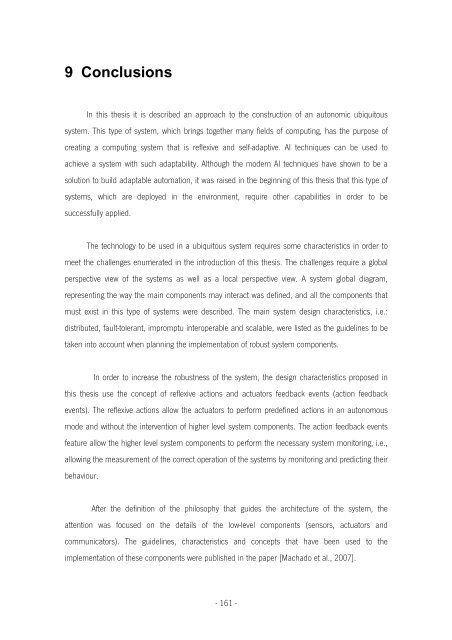Carlos Manuel Rodrigues Machado Autonomic Ubiquitous Computing
Carlos Manuel Rodrigues Machado Autonomic Ubiquitous Computing
Carlos Manuel Rodrigues Machado Autonomic Ubiquitous Computing
Sie wollen auch ein ePaper? Erhöhen Sie die Reichweite Ihrer Titel.
YUMPU macht aus Druck-PDFs automatisch weboptimierte ePaper, die Google liebt.
9 Conclusions<br />
In this thesis it is described an approach to the construction of an autonomic ubiquitous<br />
system. This type of system, which brings together many fields of computing, has the purpose of<br />
creating a computing system that is reflexive and self-adaptive. AI techniques can be used to<br />
achieve a system with such adaptability. Although the modern AI techniques have shown to be a<br />
solution to build adaptable automation, it was raised in the beginning of this thesis that this type of<br />
systems, which are deployed in the environment, require other capabilities in order to be<br />
successfully applied.<br />
The technology to be used in a ubiquitous system requires some characteristics in order to<br />
meet the challenges enumerated in the introduction of this thesis. The challenges require a global<br />
perspective view of the systems as well as a local perspective view. A system global diagram,<br />
representing the way the main components may interact was defined, and all the components that<br />
must exist in this type of systems were described. The main system design characteristics, i.e.:<br />
distributed, fault-tolerant, impromptu interoperable and scalable, were listed as the guidelines to be<br />
taken into account when planning the implementation of robust system components.<br />
In order to increase the robustness of the system, the design characteristics proposed in<br />
this thesis use the concept of reflexive actions and actuators feedback events (action feedback<br />
events). The reflexive actions allow the actuators to perform predefined actions in an autonomous<br />
mode and without the intervention of higher level system components. The action feedback events<br />
feature allow the higher level system components to perform the necessary system monitoring, i.e.,<br />
allowing the measurement of the correct operation of the systems by monitoring and predicting their<br />
behaviour.<br />
After the definition of the philosophy that guides the architecture of the system, the<br />
attention was focused on the details of the low-level components (sensors, actuators and<br />
communicators). The guidelines, characteristics and concepts that have been used to the<br />
implementation of these components were published in the paper [<strong>Machado</strong> et al., 2007].<br />
- 161 -

















